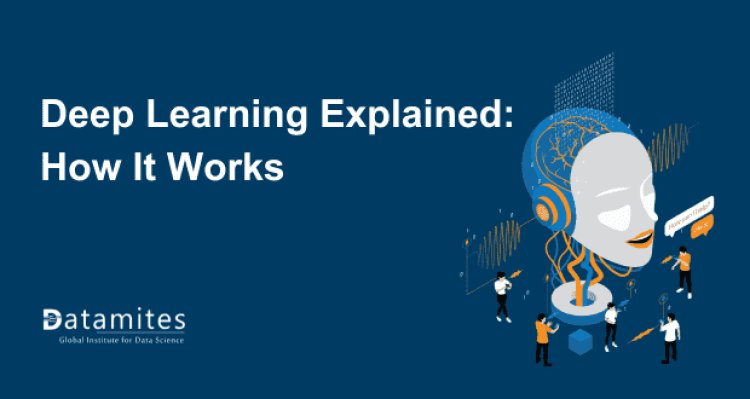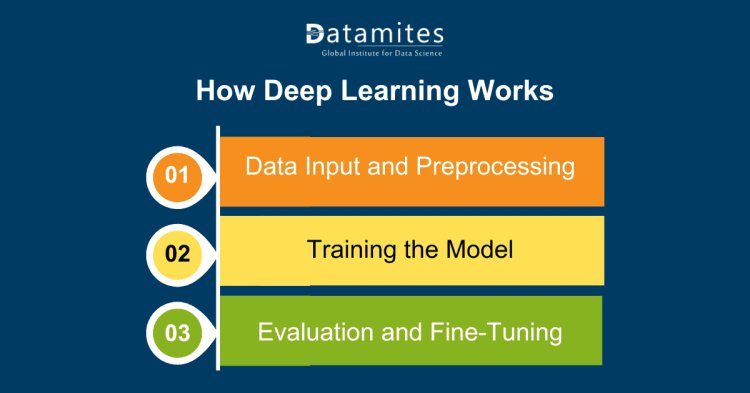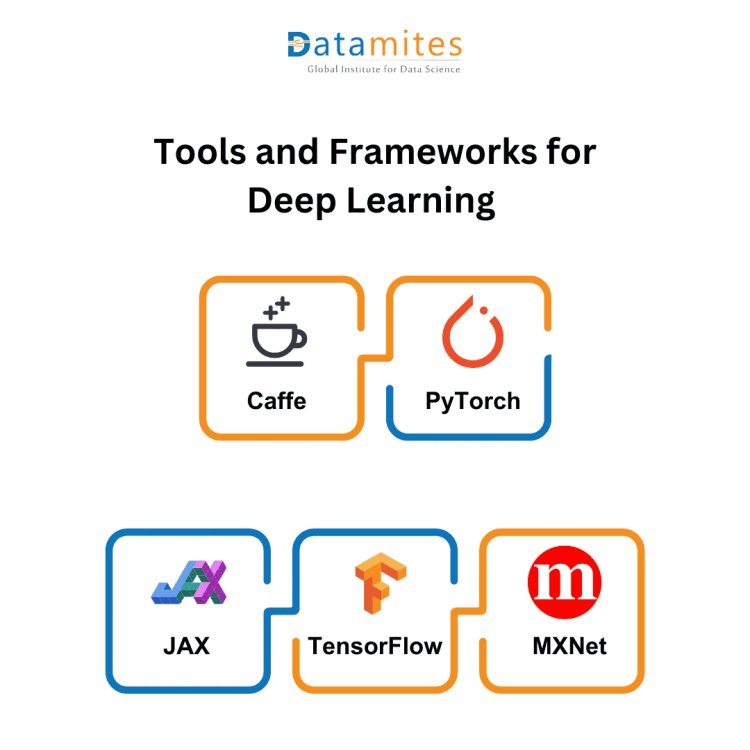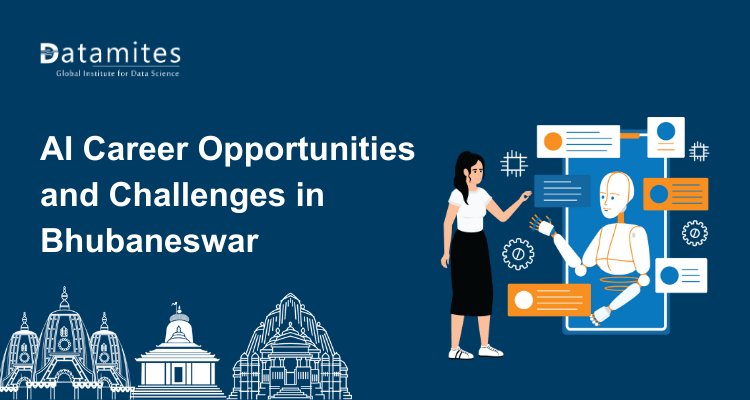Deep Learning Explained: How It Works
Deep learning is a subset of artificial intelligence that mimics the human brain to recognize patterns and make decisions. This blog explains its key concepts, applications, and how it powers technologies like voice assistants and self-driving cars.

In recent years, the world has witnessed a remarkable surge in artificial intelligence (AI) applications. From chatbots and virtual assistants to self-driving cars, Artificial Intelligence has become an integral part of our daily lives. According to a recent study by McKinsey, more than 50% of companies have integrated AI into their business processes, with deep learning being a driving force behind many of these advancements. This blog post will delve into the fascinating world of deep learning, a powerful subset of machine learning that is reshaping the technological landscape.
Grasping deep learning is essential in today's tech world for a variety of key reasons. First, it powers some of the most significant advancements in Artificial Intelligence, enabling systems to recognize images, understand speech, and predict trends with remarkable accuracy. Second, as industries increasingly adopt AI, having a grasp of deep learning concepts is essential for professionals looking to stay relevant. Enrolling in an artificial intelligence course or obtaining an artificial intelligence certification can provide individuals with the necessary skills to excel in this field.
Definition of Deep Learning
Deep learning is a specialized branch of machine learning that leverages artificial neural networks to capture and interpret intricate data patterns. Unlike traditional machine learning methods, which rely on feature extraction and rule-based approaches, deep learning automates this process through layered architectures. These structures replicate the neural networks of the human brain, allowing the model to learn from and make decisions using extensive datasets.
The Foundations of Deep Learning
The Foundations of Deep Learning encompass a range of concepts, techniques, and mathematical principles that underpin the development and application of deep learning models. Here’s a fresh breakdown of the essential elements:
What is Machine Learning?
Machine learning is a branch of artificial intelligence focused on developing algorithms that allow computers to learn from data and make predictions independently, without requiring explicit programming for particular tasks. The history of machine learning dates back to the 1950s when researchers began exploring ways to enable machines to learn from experience.
Unlike traditional programming, where rules are explicitly defined by human programmers, machine learning algorithms learn patterns from data and use these patterns to make predictions. This paradigm shift has transformed various industries, allowing for more adaptive and intelligent systems.
- Traditional Programming: Requires manual rule creation.
- Machine Learning: Learns from data autonomously.
- Deep Learning: A specialized approach in machine learning that utilizes neural networks.
The Role of Artificial Neural Networks
At the heart of deep learning are artificial neural networks, which mimic the operations of the human brain. These networks are made up of interconnected nodes, or neurons, organized in layers. Each layer processes incoming data and transmits the results to the subsequent layer, ultimately producing the final output.
The inspiration for neural networks comes from biological systems. Just as human neurons transmit signals and process information, artificial neurons perform similar tasks. This connection to human cognition enables deep learning models to understand complex data structures more effectively.
- Input Layer: Accepts data for processing.
- Hidden Layers: Perform computations and transformations.
- Output Layer: Produces the final result.
Refer these articles:
- The Impact of AI on Various Industries
- Computer Vision: An Overview of Techniques and Applications
- Why Artificial Intelligence Career in 2024
Key Concepts in Deep Learning
Deep learning is a branch of machine learning that employs multi-layered neural networks to process and interpret diverse forms of data. Understanding deep learning requires familiarity with several fundamental concepts.
Layers and Architecture
The design of a deep learning model plays a crucial role in shaping its overall effectiveness. Each layer has a specific function:
- Input Layer: In image recognition tasks, the model's input layer is where pixel values from an image are initially processed.
- Hidden Layers: These layers process the input data. Each hidden layer captures distinct features and patterns, allowing the model to understand and learn intricate representations.
- Output Layer: This layer generates the ultimate prediction or classification, with the model's accuracy relying heavily on the insights gained from the preceding layers.
Activation Functions
Activation functions are essential in shaping the output of individual neurons within a neural network. By incorporating non-linearity, they allow the model to identify complex patterns and relationships within the data. Some common activation functions include:
- Sigmoid: Produces values ranging from 0 to 1, commonly utilized in binary classification tasks.
- ReLU (Rectified Linear Unit): Outputs zero for negative inputs, promoting faster training.
- Tanh: Generates values ranging from -1 to 1, offering improved gradients for training compared to the sigmoid function.
Understanding these functions is essential for building effective deep learning models, as they significantly influence the learning process.
Training Deep Learning Models
Training a deep learning model consists of multiple stages or processes.
- Data Preparation: Refine and prepare the data to guarantee high-quality inputs.
- Forward Propagation: The model analyzes the input data as it moves through the network to generate an output.
- Loss Function: This function assesses the discrepancy between the predicted output and the actual outcome, informing necessary modifications.
- Backpropagation: The model adjusts its weights according to the loss, enhancing its learning strategy.
Having access to large datasets is crucial because they greatly enhance the model's accuracy. As deep learning models require vast amounts of data to learn effectively, investing in quality data collection is vital.

How Deep Learning Works
Deep learning, a specialized area within machine learning, utilizes neural networks with multiple layers, which is what gives it the term "deep." This approach proves to be highly efficient and is widely used in various fields, including image and speech recognition, natural language processing, and beyond. Here’s a summary of its functioning:
Data Input and Preprocessing
Ensuring high data quality is crucial before embarking on the training of a deep learning model. Implementing effective preprocessing steps is key to preparing the data for successful model training. Common techniques include:
- Normalization: Adjusting the data to a common scale, improving convergence speed.
- Augmentation: Creating new data points by modifying existing ones to improve the robustness of the model.
Supplying models with high-quality input data can greatly improve their performance and reliability.
Training the Model
At the heart of deep learning is the training process, where forward propagation plays a vital role. This stage allows the model to process data and generate predictions. During forward propagation, each neuron applies its activation function and sends the resulting output to the next layer.
After predictions are made, the loss function calculates the error. The model employs backpropagation to modify its weights, aiming to reduce the loss through optimization techniques such as gradient descent. This cycle persists until the model achieves a satisfactory level of accuracy.
Evaluation and Fine-Tuning
Once training is complete, evaluating the model's performance is essential. Frequently used evaluation metrics include:
- Accuracy: The proportion of correct predictions.
- Precision: The accuracy of positive predictions.
- Recall: The capacity to recognize all pertinent occurrences.
Techniques like regularization and hyperparameter tuning are essential for enhancing model performance. Regularization helps to mitigate overfitting, while hyperparameter tuning fine-tunes aspects like learning rates and other parameters to optimize the model's effectiveness.
Refer these articles:
- What Is AI Engineer Course
- Artificial Intelligence Career Scope in India
- Guide to Artificial Intelligence Career

Tools and Frameworks for Deep Learning
Deep learning has emerged as a vital field within artificial intelligence, supported by a variety of tools and frameworks that streamline the creation of deep learning models and facilitate artificial intelligence training. Here’s an overview of some of the most popular tools and frameworks in this field.
Popular Libraries and Frameworks
You have the ability to utilize a wide variety of libraries and frameworks for constructing deep learning models. Some of the most popular include:
- TensorFlow: Developed by Google, TensorFlow is a versatile library that supports deep learning and offers scalability, extensive community support, and integration with production environments. Its high-level API, Keras, makes it user-friendly for beginners.
- PyTorch: Created by Facebook, PyTorch is favored for its dynamic computation graph, making it intuitive for research and experimentation. It offers strong GPU acceleration and a growing ecosystem, including libraries like Fastai.
- MXNet: Known for its efficiency and scalability, MXNet supports multiple languages and is optimized for deep learning on cloud platforms, making it a popular choice for enterprise applications.
- Caffe: Developed by Berkeley AI Research, Caffe excels in image processing tasks and offers a simple configuration interface.
- JAX: A relatively new framework, JAX combines NumPy-like syntax with automatic differentiation and GPU/TPU support, making it appealing for research and development.
Hardware Requirements
Deep learning requires substantial computational resources. High-performance Graphics Processing Units (GPUs) and Tensor Processing Units (TPUs) are essential for efficient training. These specialized processors accelerate calculations, significantly reducing training time.
Additionally, cloud services like AWS and Google Cloud offer scalable solutions for deep learning, allowing users to access powerful hardware without significant upfront investment. This enhanced accessibility has paved the way for deep learning, allowing individuals and organizations to harness its potential with greater ease.
Refer these articles:
- Artificial Intelligence Course Fee in India
- Artificial Intelligence Course Fee in Bangalore
- Artificial Intelligence Course Fee in Hyderabad
Types of Deep Learning Models
Deep learning models represent a specialized category within machine learning that leverages multi-layered neural networks to extract insights from extensive datasets. Here are some common types:
Convolutional Neural Networks (CNNs)
Convolutional Neural Networks (CNNs) are distinct deep learning models specifically designed for processing and analyzing images. These models utilize convolutional layers to automatically detect and extract features from images, making them particularly effective for applications such as facial recognition and medical imaging. Some common applications of CNNs include:
- Facial Recognition: Recognizing people in photos or video footage.
- Medical Imaging: Assessing X-rays, MRIs, and CT scans for diagnostic purposes.
By mimicking the way humans perceive visual information, CNNs excel at tasks requiring spatial hierarchy.
Recurrent Neural Networks (RNNs)
RNNs are specifically designed for tasks involving sequence prediction, which makes them particularly effective for applications in natural language processing. Unlike conventional neural networks, RNNs have the ability to retain information from prior inputs, allowing them to grasp contextual nuances effectively. Their applications include:
- Language Translation: Automatically translating text from one language to another.
- Sentiment Analysis: Evaluating the emotional tone of text.
RNNs are essential for processing sequential data, delivering insights that static models simply cannot achieve.
Generative Adversarial Networks (GANs)
GANs stand out due to their unique training mechanism, which involves a competitive interaction between two neural networks: the generator and the discriminator. This dynamic fosters innovation and creativity, leading to impressive outcomes, such as:
- Image Generation: Creating realistic images from noise.
- Style Transfer: Applying artistic styles to images, producing visually appealing results.
GANs mark a major breakthrough in deep learning, highlighting its capacity for innovative and creative uses.
Deep learning is a revolutionary technology that is transforming a wide range of industries. Gaining a grasp of its fundamental concepts and applications empowers individuals to effectively engage with the rapidly changing world of artificial intelligence. Whether through an Artificial Intelligence course training program, or certification, there has never been a better moment to explore this dynamic field further.
At DataMites Institute, we are dedicated to bridging the skill gap in the tech industry by offering specialized training in data science, artificial intelligence, machine learning, and related technologies. We are excited to introduce our Artificial Engineer Course, alongside our Artificial Intelligence Expert Course and Artificial Intelligence Course for Managers. Our programs cater to learners at all levels, featuring hands-on training, real-world projects, and expert guidance. Additionally, we provide valuable internship and placement support to ensure our students are job-ready. Accredited by IABAC and NASSCOM FutureSkills, DataMites is your trusted partner in excelling in data-driven roles.
DataMites Training Institute offers a thorough Artificial Intelligence course accredited by global certifications, ensuring industry credibility. The program covers machine learning, deep learning, and AI tools through hands-on projects and expert mentorship. With flexible learning options, including online and in-person sessions, it caters to both beginners and professionals. Equipped with internationally recognized certification, DataMites prepares learners for AI-focused career opportunities.





